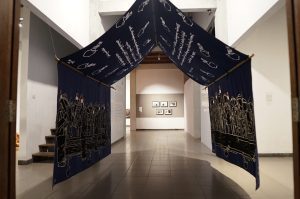Artwork in The Communication Frame
After trying to understand the two works, I pulled back my question about crossing the gap: how to see this phenomenon—observing the artwork and then incubating comments, opinions, thoughts, and/or questions—in the frame of communication?
If it can be called a phenomenon, I borrow the thoughts of David Berlo to explain it.
According to him, communication—in its simplest form—consists of at least four elements: sender, message, medium, and receiver.
 For the sake of condensing the explanation, I will consider art as a product of communication. Just like when I compared the work “Nyawiji Ibu Bumi” by Fitri DK with the news “Selamat Jalan Yu Patmi” written by Mawa Kresna, both of which touched me in almost the same way.
For the sake of condensing the explanation, I will consider art as a product of communication. Just like when I compared the work “Nyawiji Ibu Bumi” by Fitri DK with the news “Selamat Jalan Yu Patmi” written by Mawa Kresna, both of which touched me in almost the same way.
If glimpsed spontaneously, the artwork clearly communicates something.
First, artists are messengers. In short, the artist’s ideas, wherever they come from and are based on are compiled into a message. At least three things affect this process: the values, knowledge, and cultural background of the sender of the message.
Next, the arrangement of ideas is poured into a work of art. Symbols and signs become letters that are assembled into media—namely, cloth media in Fitri DK’s work and video media in Chang Jia’s work.
The media, which is already filled with symbols and signs, becomes the mouthpiece of communication to the recipient through the five senses: sight, hearing, smell, taste, and taste.
The importance of the use of media in this work of art then took my mind to the expression of the communication scientist Marshall McLuhan, “the medium is the message,” which means the media is the message.
There are two meanings to this expression: (1) communication media that determine the content of messages and (2) communication media that play a role in manipulating our images about ourselves, other people, society, and even the world by riding awareness and disturbing our perceptions.
This phrase, in my opinion, is important even though it expands slightly from David Berlo’s simple communication elements. In general, the use of cloth and video media in both works is as important as the message the artist wants to convey to the audience.
For example, look back at the work of Chang Jia who pocketed thousands of symbols and symbols in one work with video media. Especially, the torment and the smile in it. These two contradictory things usually do not have a causal relationship.
I’m sure that if the message of this performing arts was not translated using videos, the symbols and symbols that appear and their meanings might not be richer.
Experience and struggle
Now, my position is as the recipient of the message. I try to solve puzzles that arise through symbols and signs in works of art with the capacity for values, knowledge, and cultural backgrounds that I have. These three things make two things possible: to free or to shackle my mind.
This process left me, at the very least, to ask myself questions. Why this, why that? How is this, how is that?
This communication process did not stop me from continuing to feed my curiosity, while at the same time building and treading bridges over the chasm of my experience with the sour and wisdom of life from the women who inspired these works of art.
Based on the simple communication process above, at the very least, it can start the relay of women’s struggles in this country.